TLAW 101 Business Law Assignment on Contract Law and Tenders
VerifiedAdded on 2023/06/13
|9
|2034
|150
Report
AI Summary
This Business Law assignment provides a detailed analysis of contract law principles in the context of tenders and offers. It addresses two primary issues: the contractual position of a university regarding submitted tenders and the legal effects of communications leading to a potential contract. The first question examines scenarios involving multiple tenders, focusing on offer, acceptance, and the postal rule, concluding that only one tender resulted in a contractual relationship. The second question dissects a series of communications, differentiating between invitations to treat, offers, counteroffers, and requests for information, ultimately identifying the point at which a valid contract was formed. Key cases like Byrne v Van Tienhoven, Partridge v Critenden, and Hyde v Wrench are referenced to support the analysis. Desklib offers a wealth of similar solved assignments and past papers for students.

Business Law Assignment
Paraphrase This Document
Need a fresh take? Get an instant paraphrase of this document with our AI Paraphraser
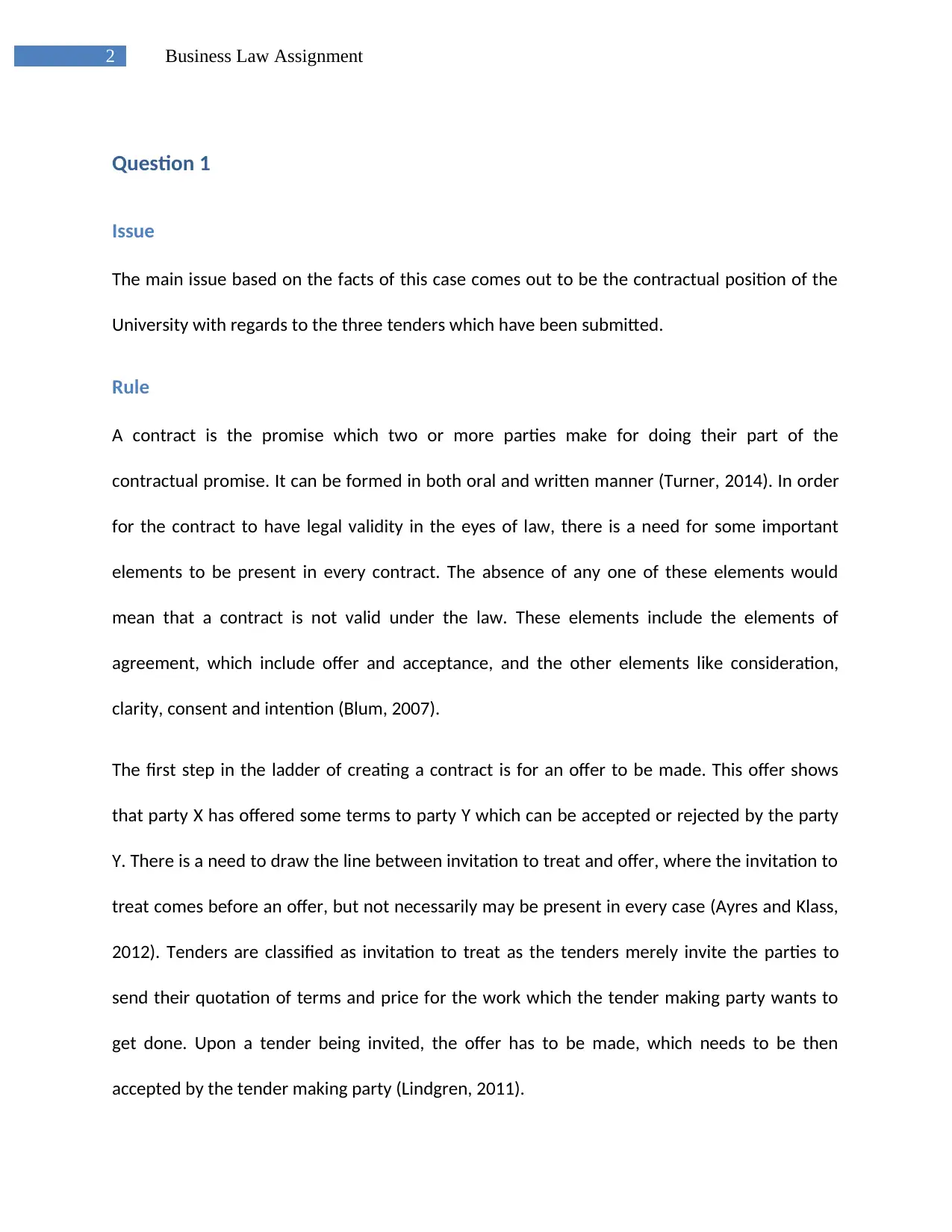
2 Business Law Assignment
Question 1
Issue
The main issue based on the facts of this case comes out to be the contractual position of the
University with regards to the three tenders which have been submitted.
Rule
A contract is the promise which two or more parties make for doing their part of the
contractual promise. It can be formed in both oral and written manner (Turner, 2014). In order
for the contract to have legal validity in the eyes of law, there is a need for some important
elements to be present in every contract. The absence of any one of these elements would
mean that a contract is not valid under the law. These elements include the elements of
agreement, which include offer and acceptance, and the other elements like consideration,
clarity, consent and intention (Blum, 2007).
The first step in the ladder of creating a contract is for an offer to be made. This offer shows
that party X has offered some terms to party Y which can be accepted or rejected by the party
Y. There is a need to draw the line between invitation to treat and offer, where the invitation to
treat comes before an offer, but not necessarily may be present in every case (Ayres and Klass,
2012). Tenders are classified as invitation to treat as the tenders merely invite the parties to
send their quotation of terms and price for the work which the tender making party wants to
get done. Upon a tender being invited, the offer has to be made, which needs to be then
accepted by the tender making party (Lindgren, 2011).
Question 1
Issue
The main issue based on the facts of this case comes out to be the contractual position of the
University with regards to the three tenders which have been submitted.
Rule
A contract is the promise which two or more parties make for doing their part of the
contractual promise. It can be formed in both oral and written manner (Turner, 2014). In order
for the contract to have legal validity in the eyes of law, there is a need for some important
elements to be present in every contract. The absence of any one of these elements would
mean that a contract is not valid under the law. These elements include the elements of
agreement, which include offer and acceptance, and the other elements like consideration,
clarity, consent and intention (Blum, 2007).
The first step in the ladder of creating a contract is for an offer to be made. This offer shows
that party X has offered some terms to party Y which can be accepted or rejected by the party
Y. There is a need to draw the line between invitation to treat and offer, where the invitation to
treat comes before an offer, but not necessarily may be present in every case (Ayres and Klass,
2012). Tenders are classified as invitation to treat as the tenders merely invite the parties to
send their quotation of terms and price for the work which the tender making party wants to
get done. Upon a tender being invited, the offer has to be made, which needs to be then
accepted by the tender making party (Lindgren, 2011).
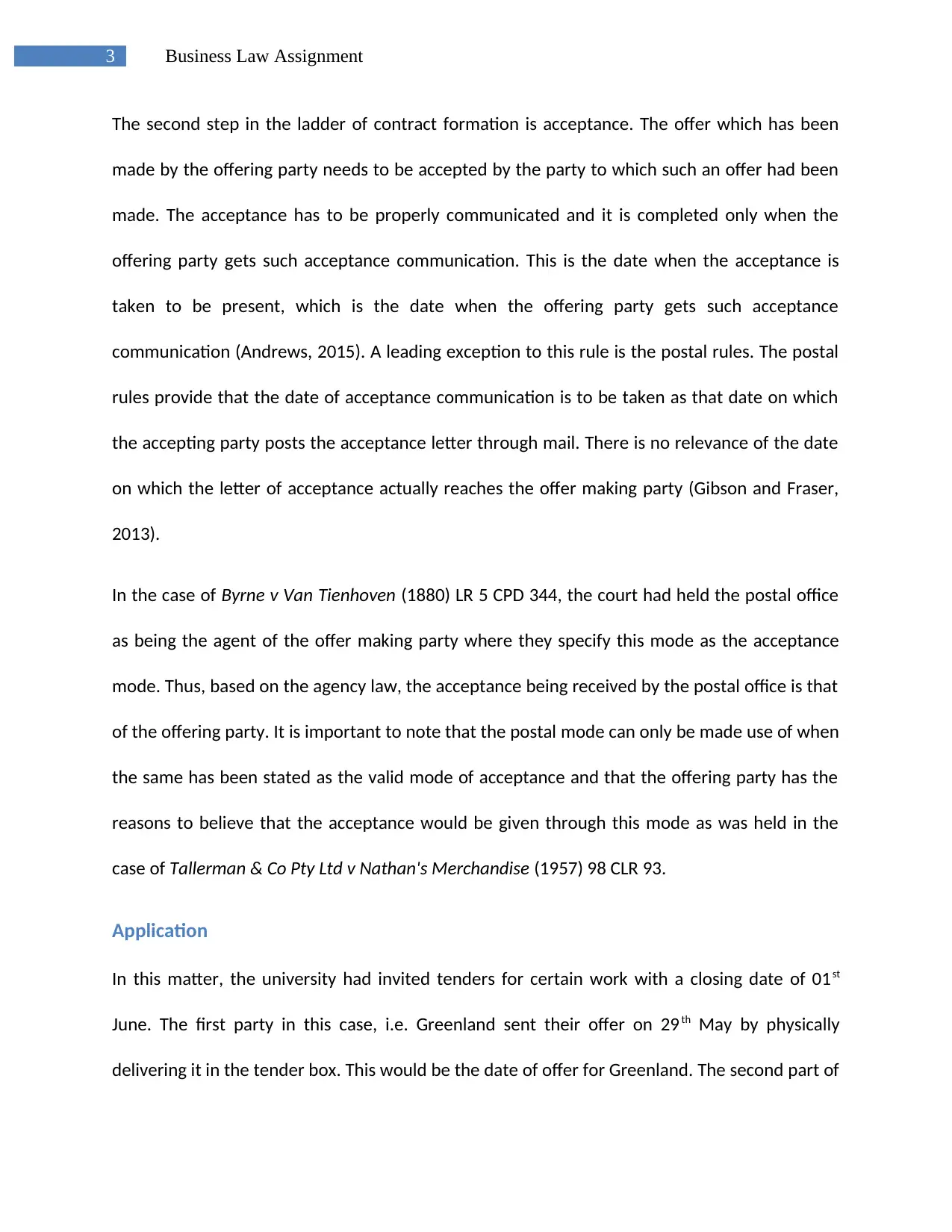
3 Business Law Assignment
The second step in the ladder of contract formation is acceptance. The offer which has been
made by the offering party needs to be accepted by the party to which such an offer had been
made. The acceptance has to be properly communicated and it is completed only when the
offering party gets such acceptance communication. This is the date when the acceptance is
taken to be present, which is the date when the offering party gets such acceptance
communication (Andrews, 2015). A leading exception to this rule is the postal rules. The postal
rules provide that the date of acceptance communication is to be taken as that date on which
the accepting party posts the acceptance letter through mail. There is no relevance of the date
on which the letter of acceptance actually reaches the offer making party (Gibson and Fraser,
2013).
In the case of Byrne v Van Tienhoven (1880) LR 5 CPD 344, the court had held the postal office
as being the agent of the offer making party where they specify this mode as the acceptance
mode. Thus, based on the agency law, the acceptance being received by the postal office is that
of the offering party. It is important to note that the postal mode can only be made use of when
the same has been stated as the valid mode of acceptance and that the offering party has the
reasons to believe that the acceptance would be given through this mode as was held in the
case of Tallerman & Co Pty Ltd v Nathan's Merchandise (1957) 98 CLR 93.
Application
In this matter, the university had invited tenders for certain work with a closing date of 01st
June. The first party in this case, i.e. Greenland sent their offer on 29 th May by physically
delivering it in the tender box. This would be the date of offer for Greenland. The second part of
The second step in the ladder of contract formation is acceptance. The offer which has been
made by the offering party needs to be accepted by the party to which such an offer had been
made. The acceptance has to be properly communicated and it is completed only when the
offering party gets such acceptance communication. This is the date when the acceptance is
taken to be present, which is the date when the offering party gets such acceptance
communication (Andrews, 2015). A leading exception to this rule is the postal rules. The postal
rules provide that the date of acceptance communication is to be taken as that date on which
the accepting party posts the acceptance letter through mail. There is no relevance of the date
on which the letter of acceptance actually reaches the offer making party (Gibson and Fraser,
2013).
In the case of Byrne v Van Tienhoven (1880) LR 5 CPD 344, the court had held the postal office
as being the agent of the offer making party where they specify this mode as the acceptance
mode. Thus, based on the agency law, the acceptance being received by the postal office is that
of the offering party. It is important to note that the postal mode can only be made use of when
the same has been stated as the valid mode of acceptance and that the offering party has the
reasons to believe that the acceptance would be given through this mode as was held in the
case of Tallerman & Co Pty Ltd v Nathan's Merchandise (1957) 98 CLR 93.
Application
In this matter, the university had invited tenders for certain work with a closing date of 01st
June. The first party in this case, i.e. Greenland sent their offer on 29 th May by physically
delivering it in the tender box. This would be the date of offer for Greenland. The second part of
⊘ This is a preview!⊘
Do you want full access?
Subscribe today to unlock all pages.

Trusted by 1+ million students worldwide
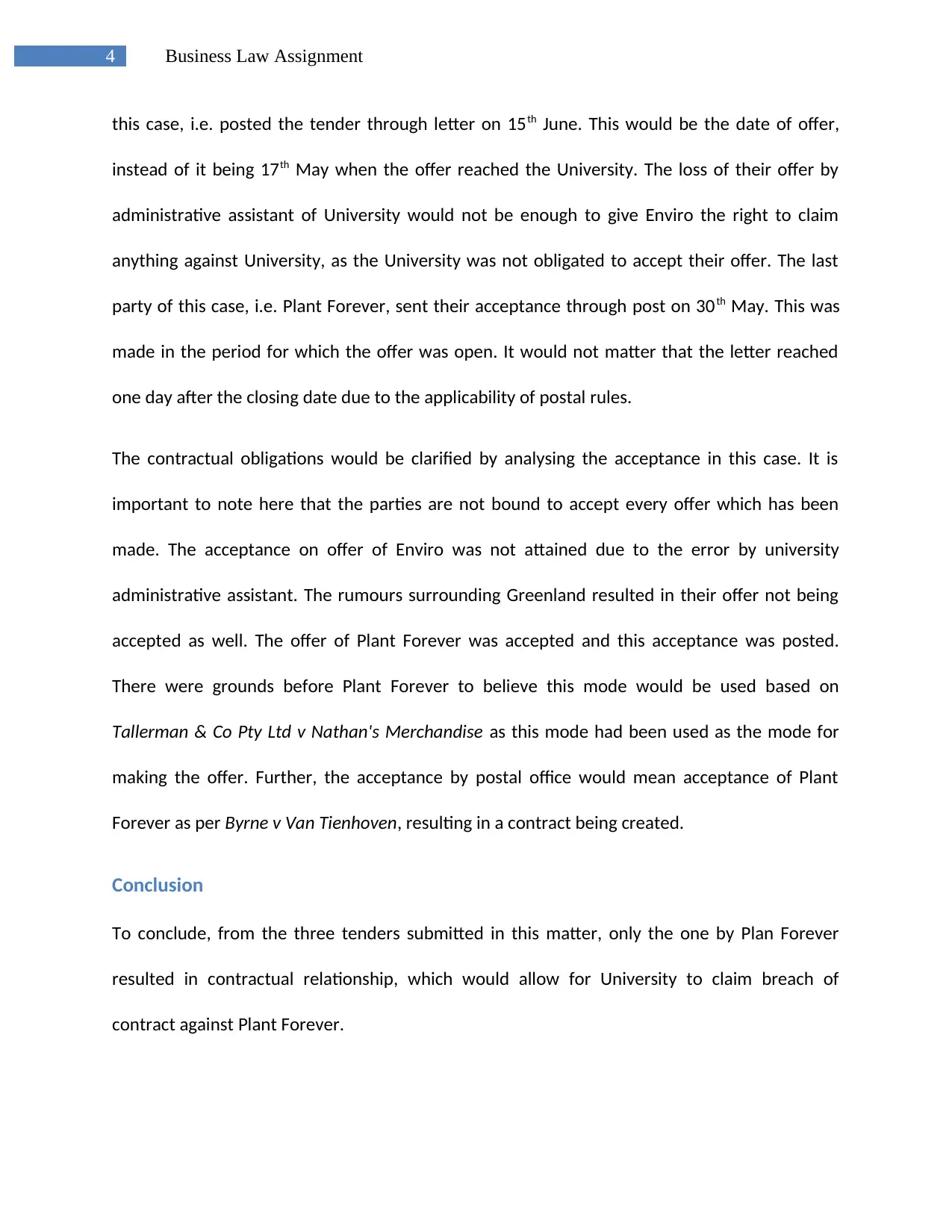
4 Business Law Assignment
this case, i.e. posted the tender through letter on 15th June. This would be the date of offer,
instead of it being 17th May when the offer reached the University. The loss of their offer by
administrative assistant of University would not be enough to give Enviro the right to claim
anything against University, as the University was not obligated to accept their offer. The last
party of this case, i.e. Plant Forever, sent their acceptance through post on 30th May. This was
made in the period for which the offer was open. It would not matter that the letter reached
one day after the closing date due to the applicability of postal rules.
The contractual obligations would be clarified by analysing the acceptance in this case. It is
important to note here that the parties are not bound to accept every offer which has been
made. The acceptance on offer of Enviro was not attained due to the error by university
administrative assistant. The rumours surrounding Greenland resulted in their offer not being
accepted as well. The offer of Plant Forever was accepted and this acceptance was posted.
There were grounds before Plant Forever to believe this mode would be used based on
Tallerman & Co Pty Ltd v Nathan's Merchandise as this mode had been used as the mode for
making the offer. Further, the acceptance by postal office would mean acceptance of Plant
Forever as per Byrne v Van Tienhoven, resulting in a contract being created.
Conclusion
To conclude, from the three tenders submitted in this matter, only the one by Plan Forever
resulted in contractual relationship, which would allow for University to claim breach of
contract against Plant Forever.
this case, i.e. posted the tender through letter on 15th June. This would be the date of offer,
instead of it being 17th May when the offer reached the University. The loss of their offer by
administrative assistant of University would not be enough to give Enviro the right to claim
anything against University, as the University was not obligated to accept their offer. The last
party of this case, i.e. Plant Forever, sent their acceptance through post on 30th May. This was
made in the period for which the offer was open. It would not matter that the letter reached
one day after the closing date due to the applicability of postal rules.
The contractual obligations would be clarified by analysing the acceptance in this case. It is
important to note here that the parties are not bound to accept every offer which has been
made. The acceptance on offer of Enviro was not attained due to the error by university
administrative assistant. The rumours surrounding Greenland resulted in their offer not being
accepted as well. The offer of Plant Forever was accepted and this acceptance was posted.
There were grounds before Plant Forever to believe this mode would be used based on
Tallerman & Co Pty Ltd v Nathan's Merchandise as this mode had been used as the mode for
making the offer. Further, the acceptance by postal office would mean acceptance of Plant
Forever as per Byrne v Van Tienhoven, resulting in a contract being created.
Conclusion
To conclude, from the three tenders submitted in this matter, only the one by Plan Forever
resulted in contractual relationship, which would allow for University to claim breach of
contract against Plant Forever.
Paraphrase This Document
Need a fresh take? Get an instant paraphrase of this document with our AI Paraphraser
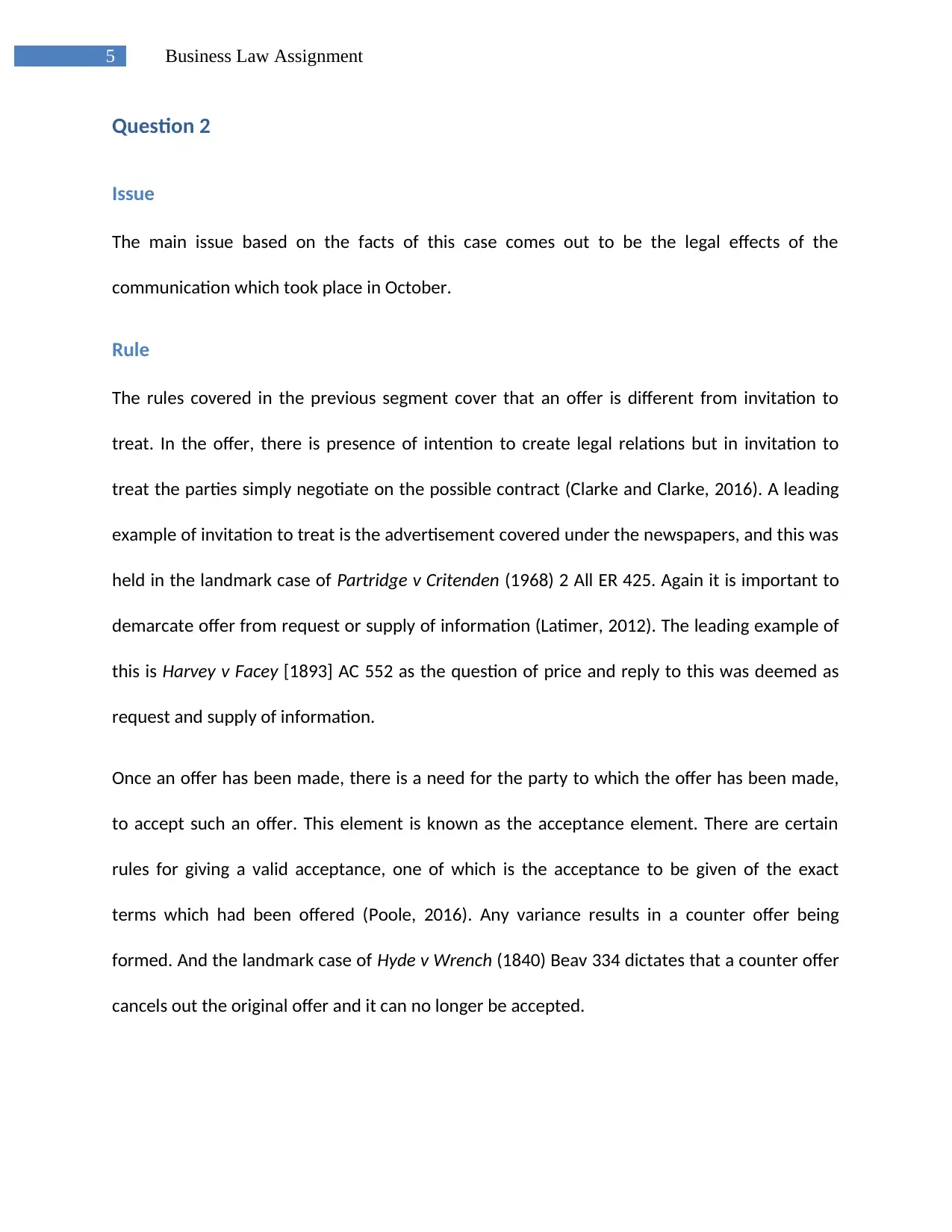
5 Business Law Assignment
Question 2
Issue
The main issue based on the facts of this case comes out to be the legal effects of the
communication which took place in October.
Rule
The rules covered in the previous segment cover that an offer is different from invitation to
treat. In the offer, there is presence of intention to create legal relations but in invitation to
treat the parties simply negotiate on the possible contract (Clarke and Clarke, 2016). A leading
example of invitation to treat is the advertisement covered under the newspapers, and this was
held in the landmark case of Partridge v Critenden (1968) 2 All ER 425. Again it is important to
demarcate offer from request or supply of information (Latimer, 2012). The leading example of
this is Harvey v Facey [1893] AC 552 as the question of price and reply to this was deemed as
request and supply of information.
Once an offer has been made, there is a need for the party to which the offer has been made,
to accept such an offer. This element is known as the acceptance element. There are certain
rules for giving a valid acceptance, one of which is the acceptance to be given of the exact
terms which had been offered (Poole, 2016). Any variance results in a counter offer being
formed. And the landmark case of Hyde v Wrench (1840) Beav 334 dictates that a counter offer
cancels out the original offer and it can no longer be accepted.
Question 2
Issue
The main issue based on the facts of this case comes out to be the legal effects of the
communication which took place in October.
Rule
The rules covered in the previous segment cover that an offer is different from invitation to
treat. In the offer, there is presence of intention to create legal relations but in invitation to
treat the parties simply negotiate on the possible contract (Clarke and Clarke, 2016). A leading
example of invitation to treat is the advertisement covered under the newspapers, and this was
held in the landmark case of Partridge v Critenden (1968) 2 All ER 425. Again it is important to
demarcate offer from request or supply of information (Latimer, 2012). The leading example of
this is Harvey v Facey [1893] AC 552 as the question of price and reply to this was deemed as
request and supply of information.
Once an offer has been made, there is a need for the party to which the offer has been made,
to accept such an offer. This element is known as the acceptance element. There are certain
rules for giving a valid acceptance, one of which is the acceptance to be given of the exact
terms which had been offered (Poole, 2016). Any variance results in a counter offer being
formed. And the landmark case of Hyde v Wrench (1840) Beav 334 dictates that a counter offer
cancels out the original offer and it can no longer be accepted.
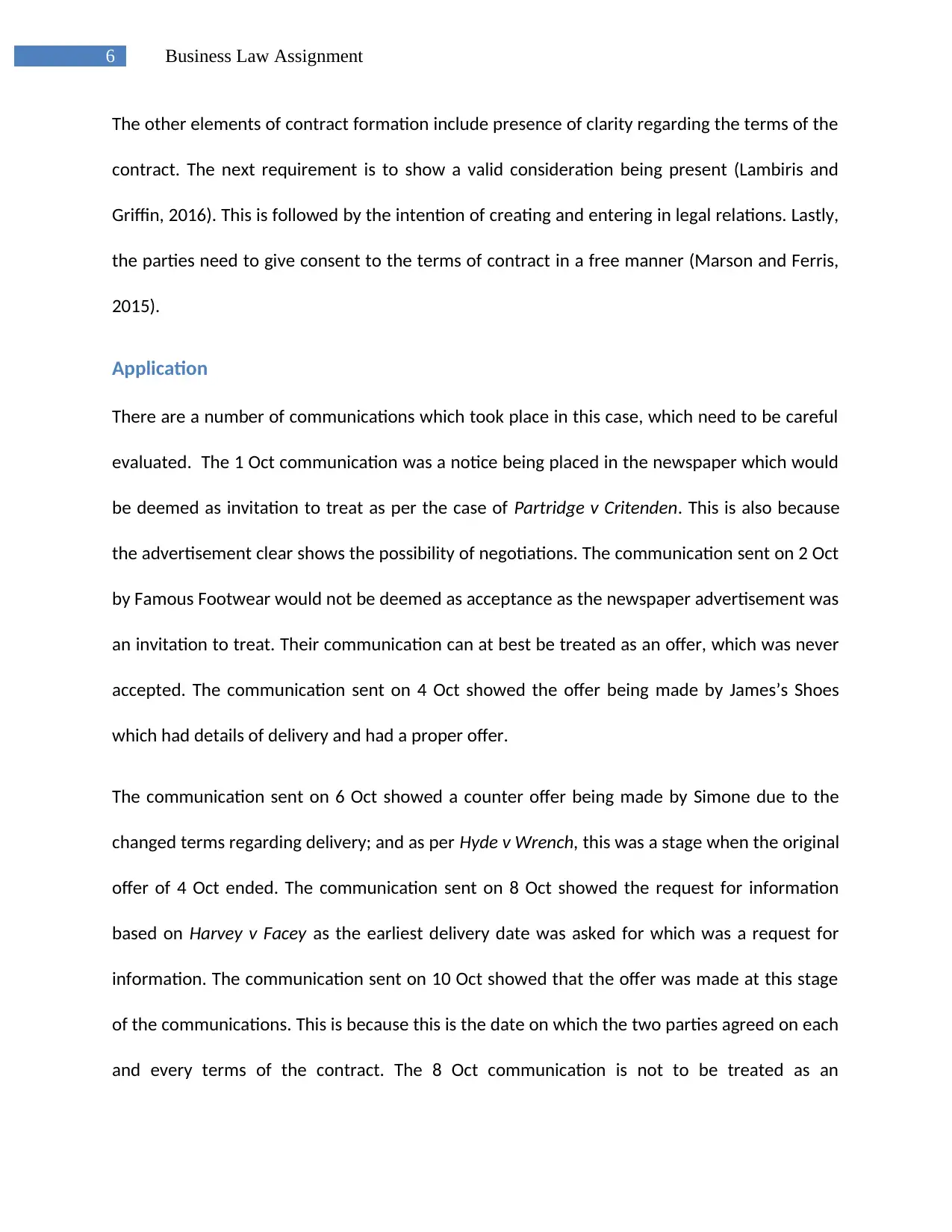
6 Business Law Assignment
The other elements of contract formation include presence of clarity regarding the terms of the
contract. The next requirement is to show a valid consideration being present (Lambiris and
Griffin, 2016). This is followed by the intention of creating and entering in legal relations. Lastly,
the parties need to give consent to the terms of contract in a free manner (Marson and Ferris,
2015).
Application
There are a number of communications which took place in this case, which need to be careful
evaluated. The 1 Oct communication was a notice being placed in the newspaper which would
be deemed as invitation to treat as per the case of Partridge v Critenden. This is also because
the advertisement clear shows the possibility of negotiations. The communication sent on 2 Oct
by Famous Footwear would not be deemed as acceptance as the newspaper advertisement was
an invitation to treat. Their communication can at best be treated as an offer, which was never
accepted. The communication sent on 4 Oct showed the offer being made by James’s Shoes
which had details of delivery and had a proper offer.
The communication sent on 6 Oct showed a counter offer being made by Simone due to the
changed terms regarding delivery; and as per Hyde v Wrench, this was a stage when the original
offer of 4 Oct ended. The communication sent on 8 Oct showed the request for information
based on Harvey v Facey as the earliest delivery date was asked for which was a request for
information. The communication sent on 10 Oct showed that the offer was made at this stage
of the communications. This is because this is the date on which the two parties agreed on each
and every terms of the contract. The 8 Oct communication is not to be treated as an
The other elements of contract formation include presence of clarity regarding the terms of the
contract. The next requirement is to show a valid consideration being present (Lambiris and
Griffin, 2016). This is followed by the intention of creating and entering in legal relations. Lastly,
the parties need to give consent to the terms of contract in a free manner (Marson and Ferris,
2015).
Application
There are a number of communications which took place in this case, which need to be careful
evaluated. The 1 Oct communication was a notice being placed in the newspaper which would
be deemed as invitation to treat as per the case of Partridge v Critenden. This is also because
the advertisement clear shows the possibility of negotiations. The communication sent on 2 Oct
by Famous Footwear would not be deemed as acceptance as the newspaper advertisement was
an invitation to treat. Their communication can at best be treated as an offer, which was never
accepted. The communication sent on 4 Oct showed the offer being made by James’s Shoes
which had details of delivery and had a proper offer.
The communication sent on 6 Oct showed a counter offer being made by Simone due to the
changed terms regarding delivery; and as per Hyde v Wrench, this was a stage when the original
offer of 4 Oct ended. The communication sent on 8 Oct showed the request for information
based on Harvey v Facey as the earliest delivery date was asked for which was a request for
information. The communication sent on 10 Oct showed that the offer was made at this stage
of the communications. This is because this is the date on which the two parties agreed on each
and every terms of the contract. The 8 Oct communication is not to be treated as an
⊘ This is a preview!⊘
Do you want full access?
Subscribe today to unlock all pages.

Trusted by 1+ million students worldwide
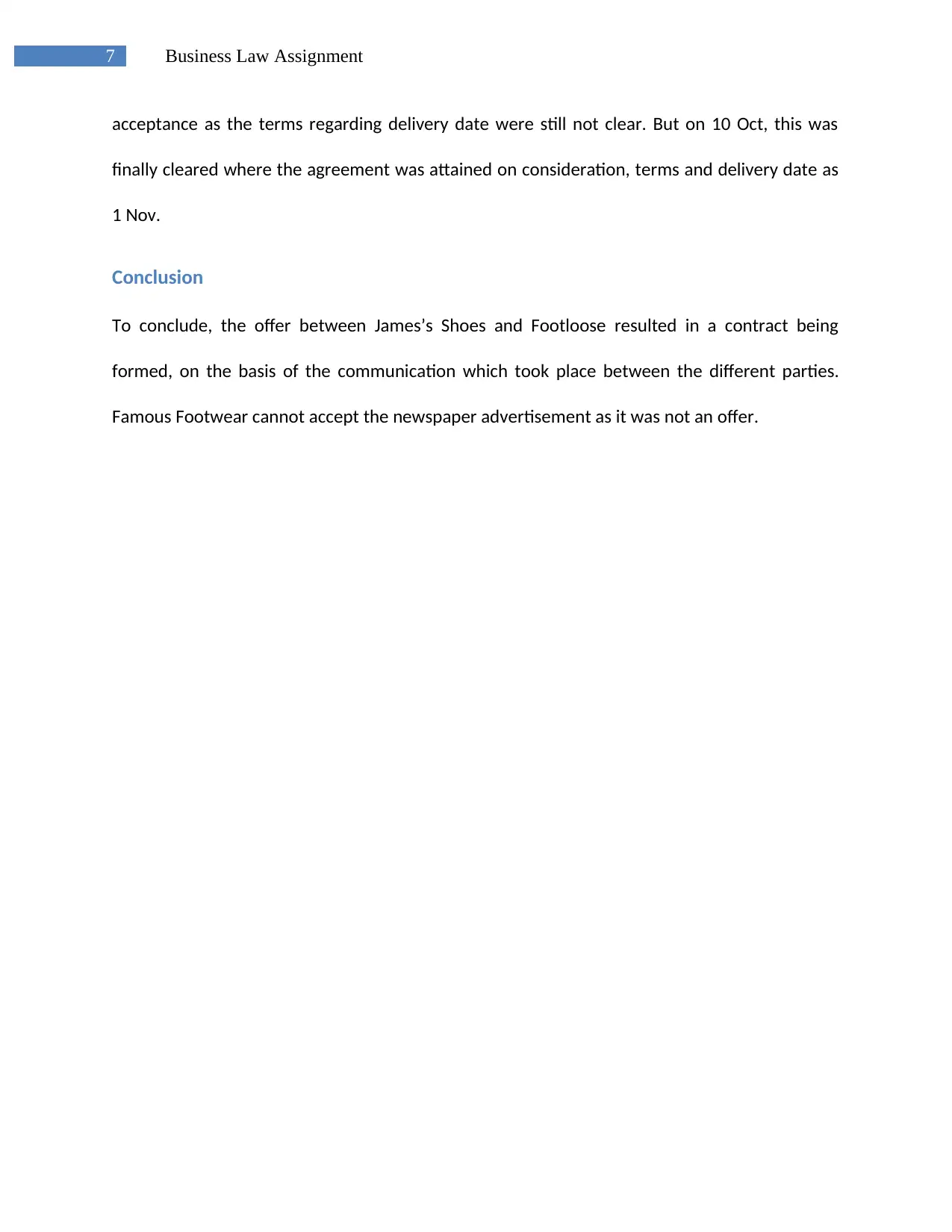
7 Business Law Assignment
acceptance as the terms regarding delivery date were still not clear. But on 10 Oct, this was
finally cleared where the agreement was attained on consideration, terms and delivery date as
1 Nov.
Conclusion
To conclude, the offer between James’s Shoes and Footloose resulted in a contract being
formed, on the basis of the communication which took place between the different parties.
Famous Footwear cannot accept the newspaper advertisement as it was not an offer.
acceptance as the terms regarding delivery date were still not clear. But on 10 Oct, this was
finally cleared where the agreement was attained on consideration, terms and delivery date as
1 Nov.
Conclusion
To conclude, the offer between James’s Shoes and Footloose resulted in a contract being
formed, on the basis of the communication which took place between the different parties.
Famous Footwear cannot accept the newspaper advertisement as it was not an offer.
Paraphrase This Document
Need a fresh take? Get an instant paraphrase of this document with our AI Paraphraser
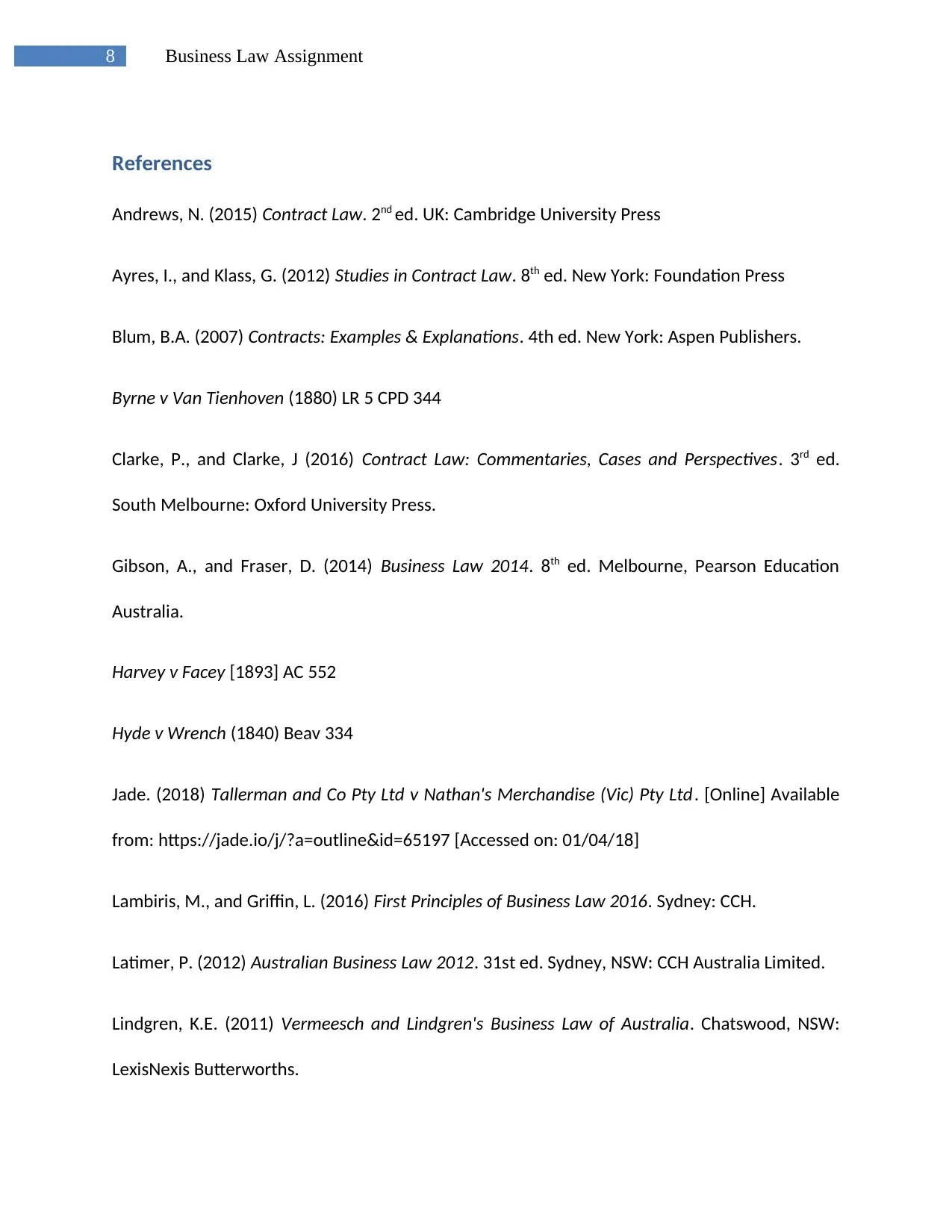
8 Business Law Assignment
References
Andrews, N. (2015) Contract Law. 2nd ed. UK: Cambridge University Press
Ayres, I., and Klass, G. (2012) Studies in Contract Law. 8th ed. New York: Foundation Press
Blum, B.A. (2007) Contracts: Examples & Explanations. 4th ed. New York: Aspen Publishers.
Byrne v Van Tienhoven (1880) LR 5 CPD 344
Clarke, P., and Clarke, J (2016) Contract Law: Commentaries, Cases and Perspectives. 3rd ed.
South Melbourne: Oxford University Press.
Gibson, A., and Fraser, D. (2014) Business Law 2014. 8th ed. Melbourne, Pearson Education
Australia.
Harvey v Facey [1893] AC 552
Hyde v Wrench (1840) Beav 334
Jade. (2018) Tallerman and Co Pty Ltd v Nathan's Merchandise (Vic) Pty Ltd. [Online] Available
from: https://jade.io/j/?a=outline&id=65197 [Accessed on: 01/04/18]
Lambiris, M., and Griffin, L. (2016) First Principles of Business Law 2016. Sydney: CCH.
Latimer, P. (2012) Australian Business Law 2012. 31st ed. Sydney, NSW: CCH Australia Limited.
Lindgren, K.E. (2011) Vermeesch and Lindgren's Business Law of Australia. Chatswood, NSW:
LexisNexis Butterworths.
References
Andrews, N. (2015) Contract Law. 2nd ed. UK: Cambridge University Press
Ayres, I., and Klass, G. (2012) Studies in Contract Law. 8th ed. New York: Foundation Press
Blum, B.A. (2007) Contracts: Examples & Explanations. 4th ed. New York: Aspen Publishers.
Byrne v Van Tienhoven (1880) LR 5 CPD 344
Clarke, P., and Clarke, J (2016) Contract Law: Commentaries, Cases and Perspectives. 3rd ed.
South Melbourne: Oxford University Press.
Gibson, A., and Fraser, D. (2014) Business Law 2014. 8th ed. Melbourne, Pearson Education
Australia.
Harvey v Facey [1893] AC 552
Hyde v Wrench (1840) Beav 334
Jade. (2018) Tallerman and Co Pty Ltd v Nathan's Merchandise (Vic) Pty Ltd. [Online] Available
from: https://jade.io/j/?a=outline&id=65197 [Accessed on: 01/04/18]
Lambiris, M., and Griffin, L. (2016) First Principles of Business Law 2016. Sydney: CCH.
Latimer, P. (2012) Australian Business Law 2012. 31st ed. Sydney, NSW: CCH Australia Limited.
Lindgren, K.E. (2011) Vermeesch and Lindgren's Business Law of Australia. Chatswood, NSW:
LexisNexis Butterworths.
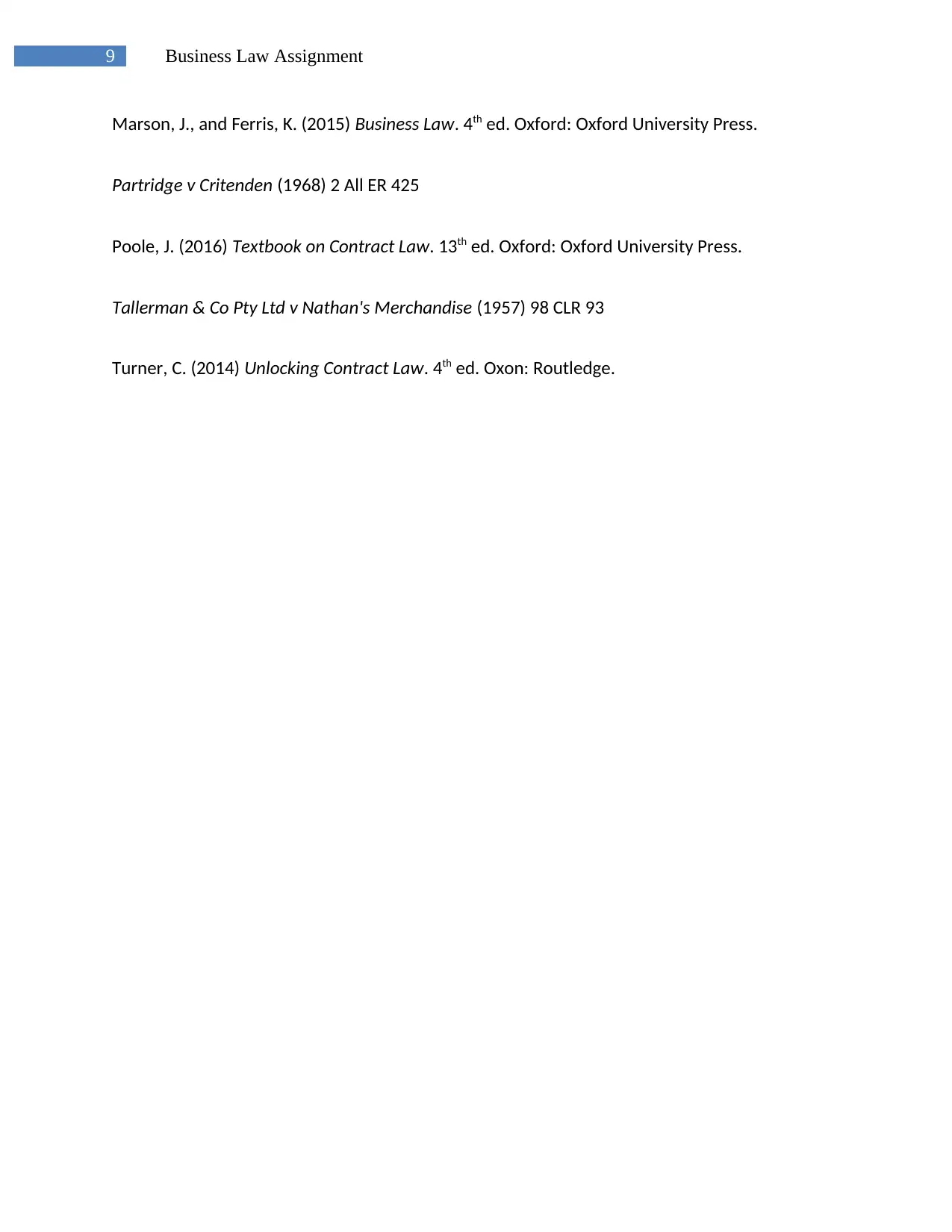
9 Business Law Assignment
Marson, J., and Ferris, K. (2015) Business Law. 4th ed. Oxford: Oxford University Press.
Partridge v Critenden (1968) 2 All ER 425
Poole, J. (2016) Textbook on Contract Law. 13th ed. Oxford: Oxford University Press.
Tallerman & Co Pty Ltd v Nathan's Merchandise (1957) 98 CLR 93
Turner, C. (2014) Unlocking Contract Law. 4th ed. Oxon: Routledge.
Marson, J., and Ferris, K. (2015) Business Law. 4th ed. Oxford: Oxford University Press.
Partridge v Critenden (1968) 2 All ER 425
Poole, J. (2016) Textbook on Contract Law. 13th ed. Oxford: Oxford University Press.
Tallerman & Co Pty Ltd v Nathan's Merchandise (1957) 98 CLR 93
Turner, C. (2014) Unlocking Contract Law. 4th ed. Oxon: Routledge.
⊘ This is a preview!⊘
Do you want full access?
Subscribe today to unlock all pages.

Trusted by 1+ million students worldwide
1 out of 9
Related Documents
Your All-in-One AI-Powered Toolkit for Academic Success.
+13062052269
info@desklib.com
Available 24*7 on WhatsApp / Email
![[object Object]](/_next/static/media/star-bottom.7253800d.svg)
Unlock your academic potential
Copyright © 2020–2025 A2Z Services. All Rights Reserved. Developed and managed by ZUCOL.




